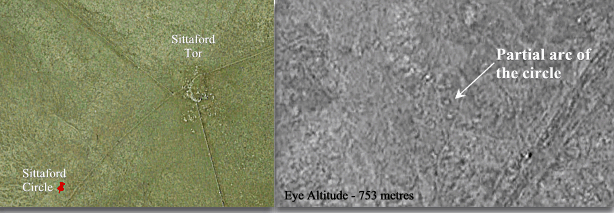
Back in 2007 Alan Endacott discovered what he thought to have been some prone stones buried in the moorland peat which appeared to form part of a stone circle. This discovery was made some 300 metres to the south west of Sittaford Tor and about 900 metres to the south west of the Grey Wethers stone circles.
Fast forward to April the 12th 2015 when an army of Dartmoor Preservation Association volunteers visited the site of the circle in order to clear it prior to a geophysical survey to taking place. Thanks to a grant from the Heritage Lottery Fund the newly formed ‘Moor than meets the Eye‘ project commissioned the geophysical survey of the stone circle. This work was carried out on the 14th of April by the Devon-based company Substrata. Previous to this some soil samples were taken from beneath two of the stones and submitted for radiocarbon dating. Both results came back showing similar calibrated dates to the end of the third millennium BC which would place them around 4,000 years old. Incidentally and unbelievably these were the very first radiocarbon samples ever to be taken from any of the Dartmoor stone circles – welcome to the 21st century. It has been suggested that this is the first discovery of a ‘new’ stone circle on Dartmoor for around one hundred years. It certainly escaped the notice of the early antiquarians and the Dartmoor Exploration Committee. In a way this was a shame because they probably would have ‘restored’ it, albeit not to its original condition but at least it would have been known prior to its recent discovery. There is more investigation work planned for the summer of 2015 when hopefully a better insight into the monument will be gained.
This stone circle sits sedately at the lofty height of 525 metres which not only makes it the highest on Dartmoor but in the whole of southern England. It consists of 30 recumbent stones now exposed thanks to the DPA’s volunteer work plus one which lies just outside the circle and is now incorporated into the partly completed enclosure wall. The circle has a diameter of 34 metres which makes it the second largest stone circle on Dartmoor, second only to the one on Mardon Down.

The actual stones that make up the circle are roughly the same shape and size and possibly came from the nearby Sittaford Tor. There is some visible evidence of packing stones around a few of the stones which would suggest that that in their original form they stood erect. The geophysical survey also revealed the presence of a wide ditch just to the east of the circle which ran in a linear direction.
To find the circle just simply follow the partially completed enclosure wall for about 300 metres in a south westerly direction from Sittaford tor. When you arrive at a standing stone in the wall the circle is on the right-hand side of the wall.
As always, such an important discovery as this inevitably leads to more questions than answers. One of the ‘big’ questions regarding this circle is why was it constructed so close to the Grey Wethers? It would be really interesting to get some radiocarbon dates from the Grey Wethers to see which circle was built first or are they both contemporary? Could it be that the Sittaford circle was the first to be built and was possibly a practice run for the Grey Wethers? Was there some sort of social change that made the Sittaford circle meaningless and it was therefore superseded by the Grey Wethers? Was there some kind of unification of two tribal groups which meant the single circle of Sittaford gave way to the combined two Grey Wethers circles?
For some reason or other in 2009 I plotted all the stone circles in the eastern part of high Dartmoor and realised that they formed what I called at the time a ‘Sacred Crescent‘ (which seems to have become a common term for them). This was due to the fact that they formed a definite crescent shape which at the time seemed to be a possible intent. This new discovery now adds another circle to the crescent and one which nicely rounds the curve off.
After further investigation work it was announced in the October of 2016 it was confirmed that the circle consisting of 30 recumbent stones is in fact, as noted above, one of the largest stone circle on Dartmoor with a diameter in excess of 30 metres. A previous geophysical survey revealed several anomalies which pointed to possible archaeological features lying hidden underground. Over five days in 2016 four trenches were excavated, three zoning in on the stones and the forth investigating an anomalously area of deep peat which lay inside the circle. Just one of the three stones showed any evidence of them standing erect and that came in the form of some packing stones. None of the target stones showed any evidence of socket holes into which the stones could have been secured. In the opinion of the Dartmoor National Park Authorities archaeologist the circle was of a ‘flimsy construction’ and maybe its construction was never completed or it was only meant to be a temporary monument in the first place. Sadly no artefacts were recovered which would have further confirmed the earlier suggested date of about 2000 BC however some peat samples were taken and sent to Plymouth University. It is hoped that the results will shed light on the date of the circle’s construction or destruction.
 Legendary Dartmoor The many aspects past and present of Dartmoor
Legendary Dartmoor The many aspects past and present of Dartmoor
